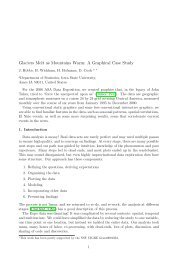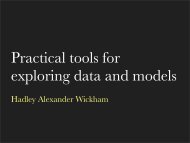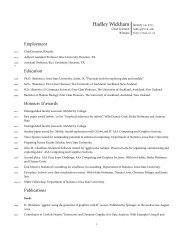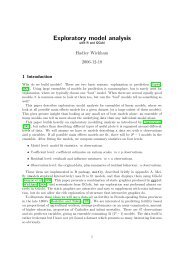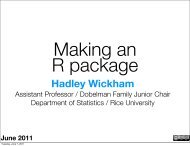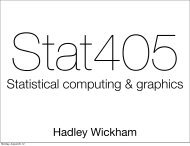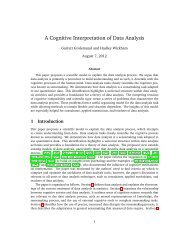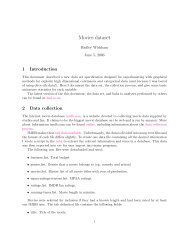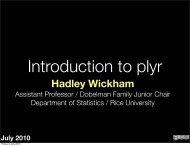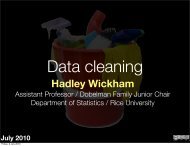Statistical inference for exploratory data analysis ... - Hadley Wickham
Statistical inference for exploratory data analysis ... - Hadley Wickham
Statistical inference for exploratory data analysis ... - Hadley Wickham
Create successful ePaper yourself
Turn your PDF publications into a flip-book with our unique Google optimized e-Paper software.
4366 A. Buja et al.<br />
such list of features cannot substitute <strong>for</strong> the wealth and surprises latent in real<br />
plots. Thus, while cumulative attempts at pre-specifying discoverable features<br />
are worthwhile endeavours, they will never be complete. Finally, because few<br />
<strong>data</strong> analysts will be willing to <strong>for</strong>ego plots in favour of scagnostics (which in<br />
fairness was not the intention of either group of authors), the problem of lack<br />
of pre-specification of discoverable features in plots remains as important and<br />
open as ever.<br />
Our attempt at cutting the Gordian Knot of prior specification is by proposing<br />
that there is no need <strong>for</strong> pre-specification of discoverable features. This can be seen<br />
by taking a closer look at what happens when <strong>data</strong> analysts hit on discoveries<br />
based on plots: they not only register the occurrence of discoveries, but also<br />
describe their nature, e.g. the nature of the observed association in a scatterplot<br />
of two variables. Thus <strong>data</strong> analysts reveal what features they respond to and<br />
hence, in stylized language, which of the test statistics T (i) (y)(i ∈ I ) resulted in<br />
rejection. In summary, among the tests that we assume to correspond to the<br />
possible discoveries but which we are unable to completely pre-specify, those that<br />
result in discovery/rejection will be known.<br />
The next question we need to address concerns the calibration of the discovery<br />
process or, in terms of testing theory, the control of Type I error. In quantitative<br />
multiple testing, one has two extreme options: <strong>for</strong> marginal or one-at-a-time<br />
Type I error control, choose the thresholds c (i) such that P(T (i) (y)>c (i) |<br />
y ∼ H0) ≤ α <strong>for</strong> all i ∈ I ; <strong>for</strong> family-wise or simultaneous Type I error control,<br />
raise the thresholds so that P(there exists i ∈ I : T (i) (y)>c (i) | y ∼ H0) ≤ α. False<br />
discovery rate control is an intermediate option. Pursuing the parallelism between<br />
quantitative testing and visual discovery further, we ask whether the practice<br />
of EDA and MD has an equivalent of Type I error control. Do <strong>data</strong> analysts<br />
calibrate their declarations of discovery? Do they gauge their discoveries to<br />
guarantee a low rate of spurious detection? They usually declare discoveries<br />
by relying on past experience and trusting their judgement. In clear-cut cases<br />
of strong structure, dispensing with explicit calibration is not a problem,<br />
but in borderline cases there is a need to calibrate visual detection without<br />
resorting to the pseudo-calibration of post hoc quantitative tests tailored to<br />
the discovery.<br />
We argue in favour of a protocol that attacks the problem at the level of<br />
plots as well as <strong>data</strong> analysts’ reactions to plots. We propose to consider <strong>data</strong><br />
analysts as black boxes whose inputs are plots of <strong>data</strong> and whose outputs are<br />
declarations of discoveries and the specifics thereof. To calibrate the discovery<br />
process, simultaneously <strong>for</strong> all discoverable features T (i) (i ∈ I ), the process is<br />
applied to ‘null <strong>data</strong>sets’ drawn from the null hypothesis, in addition to the real<br />
<strong>data</strong>set. In this manner, we learn the per<strong>for</strong>mance of the discovery process when<br />
there is nothing to discover, which is the analogue of a null distribution. We also<br />
escape the post hoc fallacy because we avoid the retroactive calibration of just<br />
the feature T (io) that the <strong>data</strong> analyst considers as discovered. In essence, we<br />
calibrate the family-wise Type I error rate <strong>for</strong> the whole family of discoverable<br />
features T (i) (i ∈ I ), even though we may be unable to completely enumerate this<br />
family. If <strong>data</strong> analysts find structure of any kind in the ‘null plots’, they will<br />
tell, and we can (i) tally the occurrences of spurious discoveries/rejections, and<br />
more specifically we can (ii) learn the most frequent types of features T (i) that<br />
get spuriously discovered.<br />
Phil. Trans. R. Soc. A (2009)<br />
Downloaded from<br />
rsta.royalsocietypublishing.org on January 7, 2010



